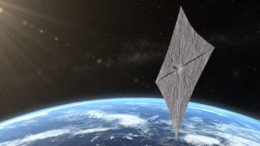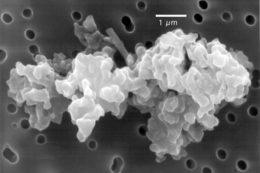More than a year has passed since the discovery of 1I/2017 ’Oumuamua, a bizarre body that burst onto the scene and then disappeared into the distance as quickly as it had arrived. During ‘Oumuamua’s visit, astronomers gathered some 800+ observations from telescopes around the world, which together reveal a strange light curve that raises more questions than answers.
A few things are agreed upon. ‘Oumuamua’s orbit indicates it originated outside of our solar system, making it the first visiting interstellar body we’ve witnessed. Its shape appears to be highly elongated, suggesting it’s more cigar-shaped than spherical. And its light curve reveals a periodicity of roughly 8 hours, potentially indicating the speed at which this odd body rotates.
But many unsolved questions remain. What are ‘Oumuamua’s structure, composition, and shape? Where did it come from? How was it launched onto its journey to our solar system?
Solar Push for a Fluffy Body?
One of ‘Oumuamua’s biggest mysteries relates to the discovery late last year that this asteroid wasn’t moving just under the influence of gravity; instead, ‘Oumuamua was experiencing a mysterious additional acceleration away from the Sun.

Artist’s impression of an artificial light sail, a thin spacecraft that can be propelled by radiation pressure. [Josh Spradling / The Planetary Society]
One study suggested this could be achieved if ‘Oumuamua took the form of a giant light sail less than a millimeter thick (naturally reinvigorating the “is it aliens?” debate). But a recent study by Amaya Moro-Martín (Space Telescope Science Institute) suggests there might be another way: ‘Oumuamua could have a more ordinary shape, but an exceedingly low density.

Image through a microscope of a porous interplanetary dust particle. Could ‘Oumuamua be an extremely low-density aggregate of icy dust? [Donald E. Brownlee (U. of Washington) and Elmar Jessberger (Institute for Planetology, Germany)]
Given this low density value, is this scenario actually likely? It turns out that fluffy, porous materials occur naturally in space, in the form of aggregates of icy dust particles. If the icy-aggregate explanation for ‘Oumuamua is correct, then the asteroid could have formed in the outer reaches of a nearby protoplanetary disk — and this could open a new window onto the study of the building blocks of planets around young stars.

Image of comet 67P/Churyumov-Gerasimenko outgassing as it is heated by the Sun. Could similar processes be occurring on ‘Oumuamua? [ESA/Rosetta/MPS for OSIRIS Team]
Added Nudge from Migrating Jets?
There’s a more mundane explanation for ‘Oumuamua’s anomalous acceleration than radiation pressure, however: outgassing, which occurs as volatiles heat beneath a body’s surface and evaporate. This process is commonly seen in the jetted tails of comets, but there are some problems with using it to explain ‘Oumuamua’s motion.
First, no outgassing was observed from ‘Oumuamua; in fact, Spitzer observations placed strict limits on the amount of carbon-based material that could be evaporating from it. Second, calculations show that traditional comet-like outgassing would create torques that would spin ‘Oumuamua up rapidly, causing it to fly apart.
A new study may have found a way around these problems, however. A publication led by Darryl Seligman (Yale University) suggests that ‘Oumuamua may have been accelerated by outgassing not from a fixed point, but from migrating jets that follow the warmth, tracking the side of the asteroid closest to the Sun. Instead of spinning out of control, ‘Oumuamua’s motion might then resemble a pendulum, gently rocking back and forth to produce the ~8-hr period seen in the light curve.

Light curves (left) and periodograms (right) for actual ‘Oumuamua observations (top row) and synthetic observations for three of the authors’ outgassing models, using three different aspect ratios for the body (next three rows). The bottom row reflects a flat photometry. Click to enlarge. [Seligman et al. 2019]
Ready for the Next Visitor
Could one of these explanations solve the mystery of ‘Oumuamua’s odd acceleration? Or could the true answer be a combination of proposed scenarios? With ‘Oumuamua long gone, we can’t be sure until we spot another interstellar visitor like it — but you can bet we’ll be prepared next time!
Citation
“Could 1I/’Oumuamua be an Icy Fractal Aggregate?,” Amaya Moro-Martín 2019 ApJL 872 L32. doi:10.3847/2041-8213/ab05df
“On the Anomalous Acceleration of 1I/2017 U1 ‘Oumuamua,” Darryl Seligman et al 2019 ApJL 876 L26. doi:10.3847/2041-8213/ab0bb5


9 Comments
Pingback: A Detailed View of Our Second Interstellar Visitor
Pingback: A Detailed View of Our Second Interstellar Visitor – Ten15AM
Pingback: A Detailed View of Our Second Interstellar Visitor - Discover Globes
Pingback: A Detailed View of Our Second Interstellar Visitor – Hamilton County Weather
Pingback: A Detailed View of Our Second Interstellar Visitor - Worldika - New Platform For Explore World
Pingback: A Detailed View of Our Second Interstellar Visitor – JWEasyTech
Pingback: A Detailed View of Our Second Interstellar Visitor – Storm-Tech Nomad
Pingback: A Detailed View of Our Second Interstellar Visitor – Digital VanLife Magazine
Pingback: Selections from 2020: No Hydrogen Ice for ‘Oumuamua